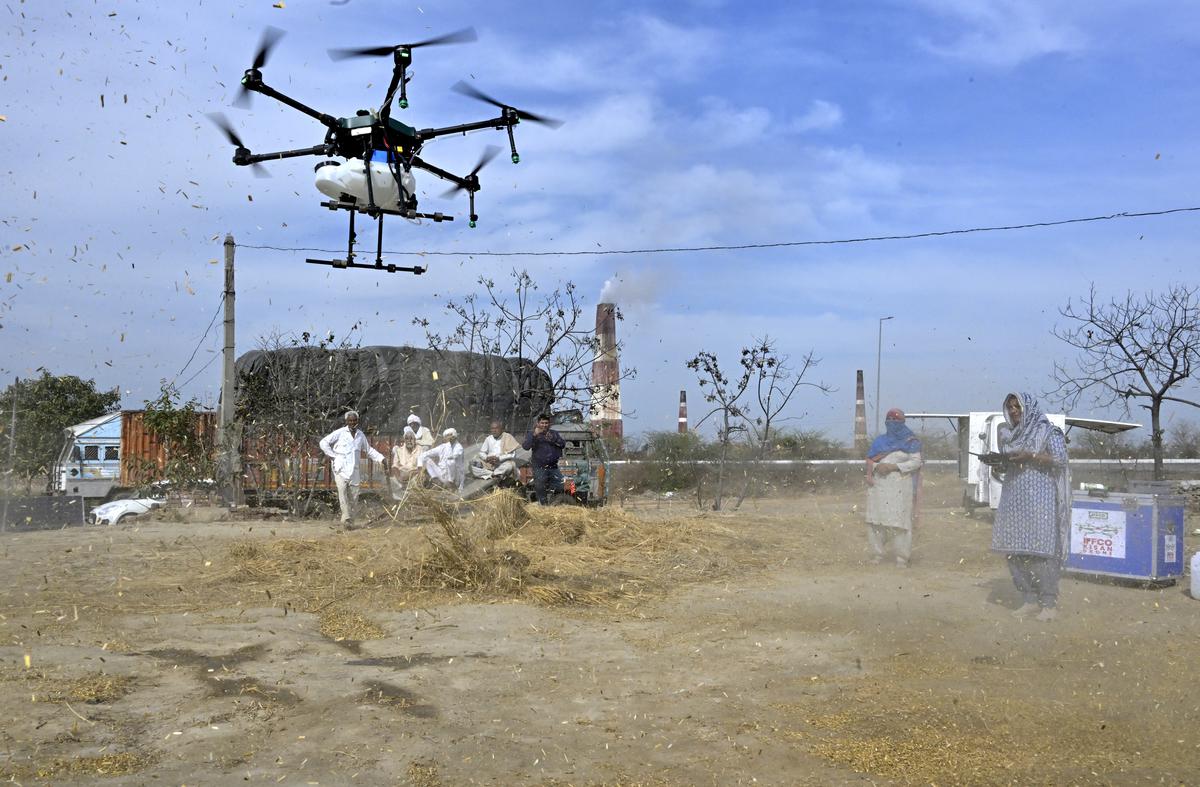The lengthy, bumpy street from ‘drone didis’ to ‘lakhpati didis’
A month earlier than farmers started their protest alongside the Punjab-Haryana border, with the police dropping tear gasoline shells from drone-based launchers, Ram Raji, 36, had been issued a drone and an electrical autorickshaw by a fertilizer firm. Raji and a number of other girls like her had been to spray liquid pesticide over the ripening wheat crop. However when the protests broke out, the drone operator from Qila Zafargarh village in Haryana’s Jind district was dissatisfied.
“There was a 12-day Web shutdown within the districts bordering Punjab and Haryana, together with Jind. Whereas working within the fields, I would like an Web connection for the GPS sign connecting to the drone,” she explains, standing in entrance of a subject of wheat, and locking an acre to be sprayed on her distant management. February is a vital month for spraying nano urea over the wheat crop, proper earlier than it flowers, and now, farmers really feel it’s too late, Raji says. Every workday misplaced additionally means a lack of revenue.
Raji is without doubt one of the preliminary 1,000 drone didis chosen by fertilizer firms from throughout India to be skilled below the Central authorities’s Namo Drone Didi scheme to fly agricultural drones that can spray fertilizers over crops. Armed with a pilot’s licence from the Directorate Common of Civil Aviation (DGCA), they’re meant to be seen as changemakers.
In November final yr, Prime Minister Narendra Modi introduced the choice to have interaction 15,000 girls from rural self-help teams (SHGs), at an authorised outlay of ₹1,261 crore, to cowl the price of drones and battery units. This quantity has not but been spent, says a Central authorities official working carefully with the scheme.
Over two months after the announcement, Mr. Modi is slated to work together with the primary 1,000 drone didis on March 11. Nonetheless, officers say actual modalities and the longer term street map are nonetheless unclear. “The federal government has deliberate for an additional 6,000 drone didis to be skilled in 2024-25, and one other 8,000 in 2025-26,” the official says.
Prices to firms
The official provides that the price of coaching the primary batch of drone didis, equipping them with the drone and its parts (4 battery units, a generator), and an electrical autorickshaw is being borne by fertilizer firms like Indian Farmers Fertiliser Cooperative Restricted (IFFCO) and Coromandel Worldwide Restricted (CIL).
“IFFCO is supporting coaching and provide of kit price ₹42 crore on the price of ₹14 lakh per girl, together with the electrical autorickshaw for 300 drone didis, whereas CIL is supporting one other 200,” the official provides. IFFCO has cited this expense as “advantages to farmers” in its books.
Amongst different firms which have assured a joint provide of 500 further drones are Krishak Bharati Cooperative (KRIBHCO), Indian Potash Restricted (IPL), Matix, Indorama India Personal Restricted, Brahmaputra Valley Fertilizer Company Restricted, and the public-sector Nationwide Fertilizers Restricted.
“The fee for every set of kit (together with a drone, 4 battery units, a generator; excluding the electrical autorickshaw) is ₹10 lakh, of which the Ministry of Agriculture and Farmers Welfare has agreed to fund as much as ₹8 lakh, whereas ₹2 lakh must be organized by the SHG,” says the official, referring to the drone didis who will probably be skilled after the primary batch.
Influencer advertising
The Haryana authorities will foot the invoice for the service offered by the drone didis, promising them ₹400 for each acre sprayed. No different State has provided this. “In Punjab, Uttar Pradesh, Andhra Pradesh, and Telangana, farmers should spend their very own cash for spraying,” the Central authorities official says.
Raji was given a goal of protecting 257 acres in Julana block over two months. Her counterpart, Kavita Dhull, 35, in Rohtak district, had a goal of 800 acres, of the 4,000 acres to be lined completely by drone didis out of the entire two lakh acres.
Nonetheless, in 40 days of labor, between January 14 and February 25, Raji has been capable of cowl solely 180 acres, averaging 4.5 acres per day, the place she was imagined to cowl six to eight acres every single day. She is helped by her brother-in-law, who drives the electrical autorickshaw and assists her in working the drone. “We’re incurring EV charging prices and labour prices and are spending from our personal pockets. We hope the promised reimbursement comes via in March,” Raji says.
Drone operator Ram Raji at Qila Zafargarh village, Jind district, Haryana.
| Photograph Credit score:
R.V. Moorthy
The Drone Didi undertaking is a subset of the Centre’s Lakhpati Didi programme, formulated for girls from SHGs to earn an annual family revenue of ₹1 lakh. The purpose is for the ladies to be influencers, each at residence and of their communities, shifting the main target from social and monetary inclusion to entrepreneurial success. The Prime Minister, via his Sunday radio broadcast, Mann Ki Baat, usually refers to ‘lakhpati didis’. It additionally discovered point out in Finance Minister Nirmala Sitharaman’s interim Funds speech this yr, and seems in commercials put out by the federal government.
Farmer trials
To encourage farmers to use to get their crops sprayed by way of drones, Haryana’s Agriculture Division, together with fertilizer firms, introduced enrolment via the web portal, Meri Fasal Mera Byora. Farmers would additionally get a one-litre nano urea bottle at ₹100, as an alternative of the ₹225 marked on the bottle, and a drone didi can be allotted to go to the fields for spraying. One bottle, combined in 10 litres of water, serves an acre.
Kuldip Singh Hooda, 40, is amongst a minority of 1,000-odd farmers in Dhamar village, Rohtak district, who has a considerable landholding of 15 acres. Most others personal land between two and 4 acres. “I had registered to get 15 acres sprayed. Nonetheless, the drone didi who got here sprayed six acres and stated she didn’t have the time to do the remainder. Nobody got here once more to spray the opposite 9 acres,” he says.
Farmers in Haryana had a tough 2023. Their rice crops had been destroyed because of heavier than regular rain throughout the monsoon, between July and August. “Half our annual revenue has been washed away,” says Manjit Hooda, one other farmer from Dhamar village. Manjit says he had tried registering on the portal, however his software didn’t undergo; nobody contacted him both.
For farmers to avail themselves of the subsidy, their farm must fall below the earmarked acreage allotted to drone didis, or else they must shell out ₹400 per acre. Many who’re debt-ridden or these with small landholdings favor to do the job manually, themselves or via less-expensive employed labour.
Historically, farmers procure granular urea in sacks, every sack of fifty kg at a subsidised price of ₹268. Labour prices for guide software is between ₹80 and ₹100 per acre, making the price of fertilizer buy and software not more than ₹368 per acre. In the event that they select to make use of the water-based medication via spray cans, the appliance remains to be ₹200 per acre, half of what the drone didis cost. “Drones then will solely be helpful on giant plantations like that of espresso, tea, or sugarcane, to make it cost-effective,” the federal government official says.
“An enormous landowner can afford drones, however there are solely 5 to 10 such wealthy farmers within the village,” says Harinder Singh, in his mid-40s, who owns two acres and farms on one other 17 acres leased out from one other landowner. “I don’t have the funds for to construct my very own home, purchase a tractor, or ship my kids to faculty. What use are drones for me?” he says.
The ladies’s challenges
Dhull makes her method down a bumpy kuccha street of Dhamar village alongside along with her assistant, who drives the electrical autorickshaw, after which helps her unload the heavy metallic field that comprises the 25-kg drone.
“I can not enterprise into the fields alone, due to security considerations. I would like a helper who can drive the EV. The automobile doesn’t simply reverse, and has even toppled over. The drone weighs almost 30 kg after being loaded with fertilizer and water. It takes two folks to lug it round,” Dhull says. She pays her assistant ₹15,000 a month. “There isn’t a provision for helpers within the scheme,” she says.
As quickly as she covers three acres, she exhausts one charged battery set wanted to fireside up the drone. She concurrently expenses one other set in her EV to cowl extra floor. Dhull finally ends up charging 4 battery units every day to complete her day’s work on the sphere. “I spend almost ₹500 to ₹600 every day on gasoline to run the generator that expenses the battery units.” She isn’t positive how the job will work out economically in the long term.
On paper although, the earnings are giant: if every drone didi covers 20 acres a day for 200 days, her earnings, at ₹300 to ₹400 per acre, will probably be ₹12-₹16 lakh per yr.
Ram Raji flying a drone that sprays fertilizer on crops.
| Photograph Credit score:
R.V. MOORTHY
Push for pesticide
India makes use of 3.5 lakh metric tonnes (MT), or 65 crore baggage, of granular urea yearly, of which 2.95 lakh MT is met with home manufacturing, whereas the rest is imported. The Central authorities then extends ₹2.45 lakh crore in subsidy to make granular urea baggage reasonably priced for farmers. Solely 7.42 crore bottles of liquid nano urea have been manufactured within the final two years. Manufacturing liquid nano urea prices ₹225 per bottle, whereas granular urea prices ₹2,000.
“Our imaginative and prescient is to enhance the capability of nano urea manufacturing to 48.5 crore bottles yearly by 2026-27, in order that we will scale back our dependence on the import of pricy granular urea,” the federal government official explains. Nonetheless, liquid nano urea (which is sprayed by drones or by the knapsack technique) can not fully exchange conventional granular urea, as farms want fertilizers thrice in each crop cycle. Liquid could be sprayed solely as soon as, as solely granular urea is efficient on the sowing stage, and a fertilizer can solely be used on the roots as soon as the flowering begins, they add.
Many questions stay to be answered. “As an illustration, who could have the possession of the drone? Will or not it’s with the person, the SHG she belongs to, the village organisation (VO) below which the SHG comes, or the cluster stage federation (CLF) that consists of many village organisations?” says a supply working within the Namo Drone Didi implementation committee. Once more, there isn’t readability round future earnings. Will the cash be the girl’s or will a few of it circulate to the SHG, VO, or CLF?
Final yr, the Agriculture Ministry had floated a proposal for procuring 300 drones below Krishi Vigyan Kendras (KVKs), centres connected to agricultural universities that conduct analysis. “Whereas some KVKs are utilizing drones, others aren’t. Earlier than saying one other drone-related scheme, it could have been vital to grasp the learnings of KVKs whereas utilizing drones,” an official from the Agriculture Ministry added. “Additionally, farmers are free to purchase their very own drones, so think about if a couple of farmers band collectively to purchase their drone, it’s going to eat into the enterprise of drone didis,” the official provides.
In the meantime, Dhull has sprayed almost 600 acres in Rohtak, and is now ready for her cash to be reimbursed by the Haryana authorities for her providers. Now that the wheat is flowering, there’s a lull in work for 2 months. “Let’s see once we will receives a commission,” she says.






